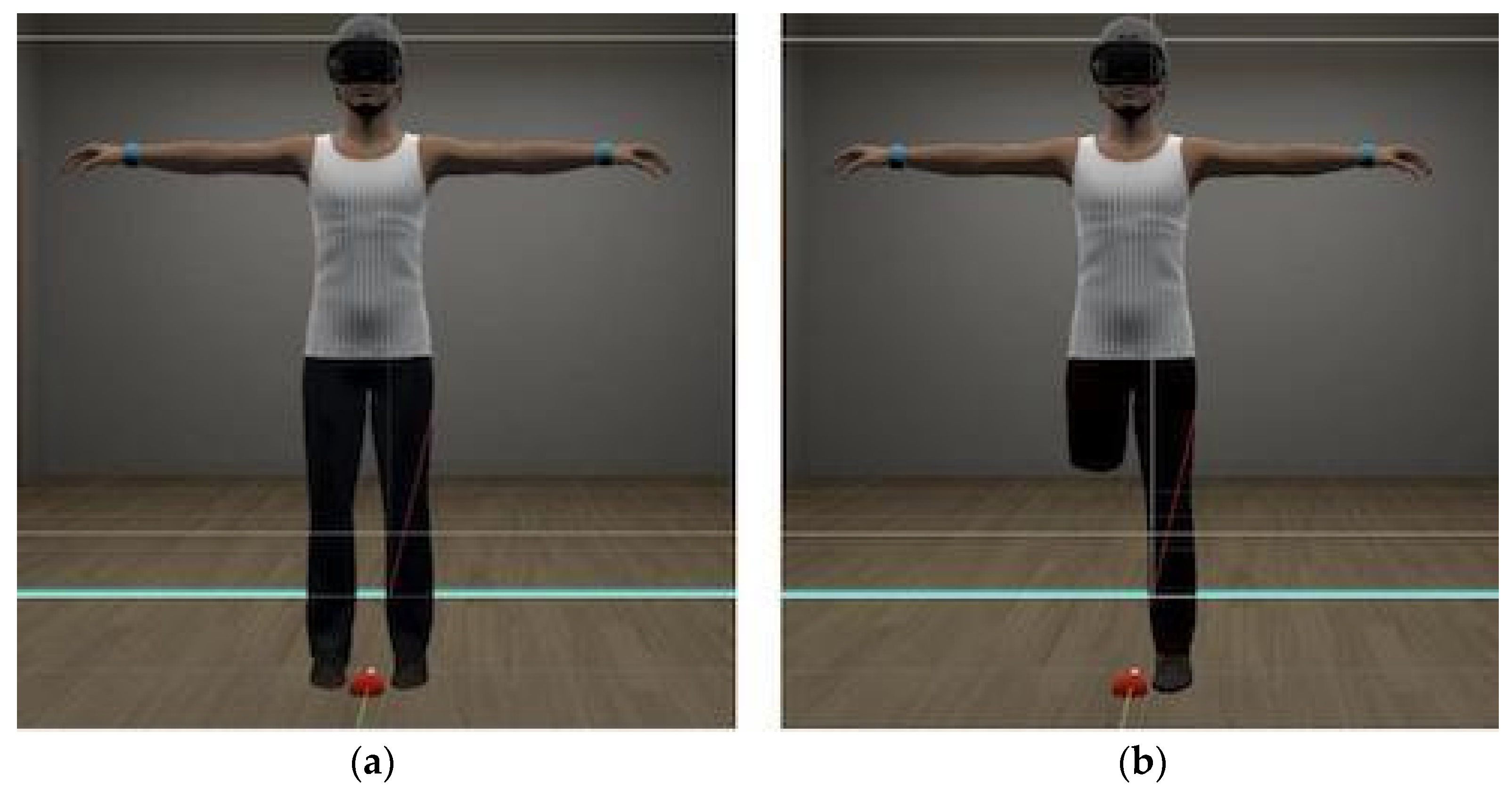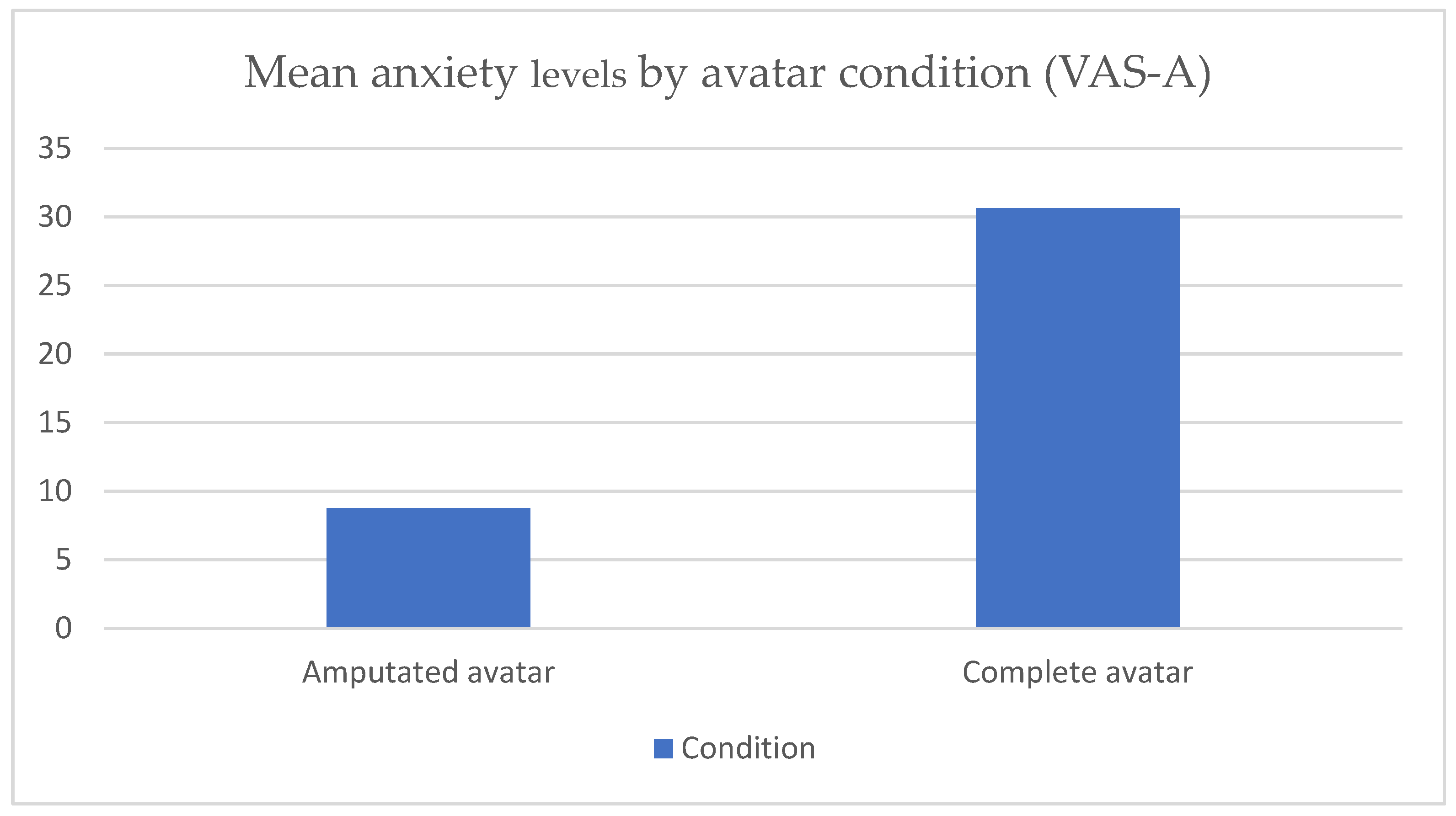Evaluating Psychological Effects of Amputation Through Virtual Reality Embodiment: A Study on Anxiety and Body Appreciation
Abstract
1. Introduction
2. Materials and Methods
2.1. Participants
2.2. Instruments
2.2.1. Hardware and Software
2.2.2. Body Appreciation Scale (BAS)
2.2.3. Visual Analogue Scale for Anxiety (VAS-A)
2.3. Procedure
3. Results
3.1. Statistical Analyses
3.2. Descriptive Results
4. Discussion
5. Conclusions
Author Contributions
Funding
Institutional Review Board Statement
Informed Consent Statement
Data Availability Statement
Conflicts of Interest
References
- Tavera, J. Amputación: Más allá de un cambio físico, un cambio mental. Rev. Dolor 2014, 62, 20–22. [Google Scholar]
- Instituto Nacional de Estadística (INE). Encuesta de Discapacidad, Autonomía Personal y Situaciones de Dependencia 2008 Discapacidades, Deficiencias y Estado de Salud; Resultados nacionales: Cifras relativas; Instituto Nacional de Estadística (INE): Madrid, Spain, 2008. [Google Scholar]
- McDonald, C.L.; Westcott-McCoy, S.; Weaver, M.R.; Haagsma, J.; Kartin, D. Global prevalence of traumatic non-fatal limb amputation. Prosthet. Orthot. Int. 2021, 45, 105–114. [Google Scholar] [CrossRef]
- Díaz, J.L.; Leal, C.; Echevarría, P. La comunicación entre el personal sanitario y los afectados por una amputación traumática: La sábana por encima. Rev. Comun. Salud 2013, 3, 5–19. [Google Scholar] [CrossRef]
- Bañol, S.M.; Briceño, D.C.; Parra, S.M.; Rodríguez, A.; Rojas, M.J. Paciente amputado de miembro inferior: Necesidades físicas, emocionales y sociales insatisfechas. Rev. Repert. Med. Cir. 2003, 12, 144–150. [Google Scholar] [CrossRef]
- Engel, G.L. The need for a new medical model: A challenge for biomedicine. Science 1977, 196, 129–136. [Google Scholar] [CrossRef] [PubMed]
- Freysteinson, W.; Thomas, L.; Sebastian-Deutsch, A.; Douglas, D.; Melton, D.; Celia, T.; Reeves, K.; Bowyer, P. A Study of the Amputee Experience of Viewing Self in the Mirror. Rehabil. Nurs. 2017, 42, 22–32. [Google Scholar] [CrossRef] [PubMed]
- Carter, M.J. The role of body image in the amputee experience. Prosthet. Orthot. Int. 2012, 36, 1446–1450. [Google Scholar]
- Sousa, C.; Corredeira, R.; Pereira, L. Physical rehabilitation and body image: A narrative review. J. Rehabil. Res. Dev. 2009, 46, 234–246. [Google Scholar]
- Huang, Y.; Lin, S.; Chen, X. Gender differences in body appreciation and its associations with psychiatric symptoms among Chinese college students. Front. Psychol. 2021, 12, 657342. [Google Scholar] [CrossRef]
- Jiménez-Cabello, J.; González-Sánchez, C.; Rodríguez-Ruíz, S.; Mata-Martín, J.L. Mirror Exposure Therapy for Individuals with Obesity: Impacts on Body Appreciation and Anxiety. J. Psychosom. Res. 2024, 123, 102912. [Google Scholar]
- Ramirez, S.; Thompson, J.K.; Roberts, M.E.; Fletcher, K.A. Body image disturbances and mirror exposure in eating disorders: An overview. Int. J. Eat. Disord. 2018, 51, 1155–1165. [Google Scholar] [CrossRef]
- Picot, A.; Williams, C.L.; Martin, F.; Green, J.T. The effect of mirror exposure on body appreciation and anxiety: A systematic review. J. Psychol. Res. 2022, 12, 55–67. [Google Scholar]
- Summa, T.; Hughes, R.A.; Johnson, C.R.; Blake, T.J. Mirror therapy in the treatment of phantom limb pain: A review of the literature. J. Rehabil. Res. Dev. 2021, 58, 101–113. [Google Scholar]
- Porras-García, B.; Ferrer-García, M.; Serrano-Troncoso, E.; Carulla-Roig, M.; Gutiérrez-Maldonado, J. Virtual reality body exposure therapy for anorexia nervosa: A case study. J. Eat. Disord. 2020, 8, 20–25. [Google Scholar]
- Serino, S.; Pedroli, E.; Pallavicini, F.; Cipresso, P.; Riva, G. Virtual reality and mirror exposure in body image interventions. Cyberpsychol. Behav. Soc. 2021, 24, 651–657. [Google Scholar]
- Arbona, C.B.; García-Palacios, A.; Baños, R.M. Realidad virtual y tratamientos psicológicos. Cuad. Med. Psicosomática Psiquiatría Enlace 2007, 82, 17–31. [Google Scholar]
- Gutiérrez-Maldonado, J.; Wiederhold, B.K.; Riva, G. Future Directions: How Virtual Reality Can Further Improve the Assessment and Treatment of Eating Disorders and Obesity. Cyberpsychol. Behav. Soc. Netw. 2016, 19, 148–153. [Google Scholar] [CrossRef]
- Gutiérrez-Maldonado, J.; Ferrer-García, M.; Dakanalis, A.; Riva, G. Virtual reality: Applications to eating disorders. In The Oxford Handbook of Eating Disorders; Stewart, A.W., Robinson, A., Eds.; Oxford University Press: Oxford, UK, 2018; pp. 470–491. [Google Scholar]
- González, J. Realidad Virtual Para el Dolor por Miembro Fantasma. Bachelor’s Thesis, Universitat de les Illes Balears, Palma, Spain, 2018. [Google Scholar]
- Slater, M.; Pérez-Marcos, D.; Ehrsson, H.; Sanchez-Vives, M.V. Inducing illusory ownership of a virtual body. Front. Neurosci. 2009, 3, 29. [Google Scholar] [CrossRef]
- Botvinick, M.; Cohen, J. Rubber hands ‘feel’ touch that eyes see. Nature 1998, 391, 756. [Google Scholar] [CrossRef]
- Fisher, K.; Hanspal, R. Body image and patients with amputations: Does the prosthesis maintain the balance? Int. J. Rehabil. Res. 1998, 21, 355–363. [Google Scholar] [CrossRef]
- González-Sánchez, C.; Jiménez-Cabello, J.; Rodríguez-Ruíz, S.; Mata-Martín, J.L. “I’m Not Only a Body”: Change in thoughts about the body after mirror exposure treatment in women with obesity—An exploratory study. Healthcare 2024, 12, 624. [Google Scholar] [CrossRef] [PubMed]
- Mckechnie, P.S.; John, A. Anxiety and depression following traumatic limb amputation: A systematic review. Injury 2014, 45, 1859–1866. [Google Scholar] [CrossRef]
- Acosta, M.V.; Gómez, G. Insatisfacción corporal y seguimiento de dieta. Una comparación transcultural entre adolescentes de España y México. Int. J. Clin. Health Psychol. 2003, 3, 9–21. [Google Scholar]
- Avalos, L.; Tylka, T.L.; Wood-Barcalow, N. The Body Appreciation Scale: Development and psychometric evaluation. Body Image 2005, 2, 285–297. [Google Scholar] [CrossRef] [PubMed]
- Lobera, I.J.; Ríos, P.B. Spanish version of the Body Appreciation Scale (BAS) for adolescents. Span. J. Psychol. 2011, 14, 411–420. [Google Scholar] [CrossRef] [PubMed]
- Tiggemann, M.; McCourt, A. Body appreciation in adult women: Relationships with age and body satisfaction. Body Image 2013, 10, 624–627. [Google Scholar] [CrossRef]
- Gift, A.G. Visual analogue scales: Measurement of subjective phenomena. Nurs. Res. 1989, 38, 286–288. [Google Scholar] [CrossRef]
- Hornblow, A.R.; Kidson, M.A. The visual analogue scale for anxiety: A validation study. Aust. N. Z. J. Psychiatry 1976, 10, 339–341. [Google Scholar] [CrossRef]
- Waltemate, T.; Gall, D.; Roth, D.; Botsch, M.; Latoschik, M.E. The impact of avatar personalization and immersion on virtual body ownership, presence, and emotional response. IEEE Trans. Vis. Comput. Graph. 2018, 24, 1643–1652. [Google Scholar] [CrossRef]
- Gonzalez-Franco, M.; Peck, T. Avatar embodiment: Towards a standardized questionnaire. Front. Robot. AI 2018, 5, 74. [Google Scholar] [CrossRef]
- Perkins, Z.B.; De’Ath, H.D.; Sharp, G.; Tai, N.R.M. Factors affecting outcome after traumatic limb amputation. Br. J. Surg. 2012, 99, 75–86. [Google Scholar] [CrossRef] [PubMed]
- Horgan, O.; MacLachlan, M. Psychosocial adjustment to lower-limb amputation: A review. Disabil. Rehabil. 2004, 26, 837–850. [Google Scholar] [CrossRef] [PubMed]
- Calabrese, L.; Maffoni, M.; Torlaschi, V.; Pierobon, A. What Is Hidden behind Amputation? Quanti-Qualitative Systematic Review on Psychological Adjustment and Quality of Life in Lower Limb Amputees for Non-Traumatic Reasons. Healthcare 2023, 11, 1661. [Google Scholar] [CrossRef] [PubMed] [PubMed Central]
- Desmond, D.M.; MacLachlan, M. Affective distress and amputation-related pain among older men with long-term, traumatic limb amputations. J. Pain Symptom Manag. 2006, 31, 362–368. [Google Scholar] [CrossRef] [PubMed]
- Cheung, J.C.W.; Cheung, D.S.K.; Ni, M.; Chen, K.W.; Mao, Y.J.; Feng, L.; Leung, A.K.L. X-reality for phantom limb management for amputees: A systematic review and meta-analysis. Eng. Regen. 2023, 4, 134–151. [Google Scholar] [CrossRef]
- Donnelly, M.R.; Reinberg, R.; Ito, K.L.; Saldana, D.; Neureither, M.; Schmiesing, A.; Liew, S.L. Virtual reality for the treatment of anxiety disorders: A scoping review. Am. J. Occup. Ther. 2021, 75, 7506205040. [Google Scholar] [CrossRef]
- Guarese, R.L.M.; de Jesus Oliveira, V.A.; Calepso, A.; Valer, R.; Iquiapaza, Y.; Nedel, L.P.; Maciel, A. E-mpathy and the Phantom Limb Sensation: A Multisensory Experience for Embodiment of Amputation. In Proceedings of the XCR Conference Proceedings, Sankt Pölten, Austria, 28 April 2020; pp. 13–16. [Google Scholar]
- Botella, C.; Baños, R.M.; Guillén, V.; Perpiñá, C.; Alcañiz, M. Virtual reality exposure-based therapy in the treatment of post-traumatic stress disorder. In Virtual Reality in Psychological, Medical, and Pedagogical Applications; Alcañiz, M., Rey, B., Eds.; Intechopen: Rijeka, Croatia, 2017; pp. 137–156. [Google Scholar]
- Carl, E.; Stein, A.T.; Levihn-Coon, A.; Pogue, J.R.; Rothbaum, B.; Emmelkamp, P.; Asmundson, G.J.; Powers, M.B. Virtual reality exposure therapy for anxiety and related disorders: A meta-analysis of randomized controlled trials. J. Anxiety Disord. 2019, 61, 27–36. [Google Scholar] [CrossRef]
- Rognini, G.; Petrini, F.M.; Raspopovic, S.; Valle, G.; Granata, G.; Strauss, I.; Blanke, O. Multisensory bionic limb to achieve prosthesis embodiment and reduce distorted phantom limb perceptions. J. Neurol. Neurosurg. Psychiatry 2019, 90, 833–836. [Google Scholar] [CrossRef]


| N | Range | Min | Max | Avg | Variability | Kurtosis | Error | |
|---|---|---|---|---|---|---|---|---|
| Embodiment Total (without response scale) | 36 | 2.00 | −0.04 | 1.96 | 1.03 | 0.07 | 0.05 | 0.76 |
| BAS Total | 36 | 37 | 28 | 65 | 51.13 | 1.27 | 1.22 | 1.26 |
| VAS-A 1 Total | 36 | 95 | 0 | 95 | 8.77 | 3.25 | 12.30 | 3.42 |
| VAS-A 2 Total | 36 | 100 | 0 | 100 | 30.63 | 4.43 | 0 | 4.43 |
| N | 36 |
| Sum Sq | Df | F | PR (>F) | |
|---|---|---|---|---|
| C (Condition) | 57.617495 | 1.0 | 30.417829 | 5.661744 × 10−7 |
| BAS Score | 24.243403 | 1.0 | 12.798746 | 6.395585 × 10−4 |
| VAS-A 1 Total | 36 | 95 | 0 | 95 |
| Residual | 130.699900 | 69.0 | NaN | NaN |
Disclaimer/Publisher’s Note: The statements, opinions and data contained in all publications are solely those of the individual author(s) and contributor(s) and not of MDPI and/or the editor(s). MDPI and/or the editor(s) disclaim responsibility for any injury to people or property resulting from any ideas, methods, instructions or products referred to in the content. |
© 2024 by the authors. Licensee MDPI, Basel, Switzerland. This article is an open access article distributed under the terms and conditions of the Creative Commons Attribution (CC BY) license (https://creativecommons.org/licenses/by/4.0/).
Share and Cite
Manzano-Torra, A.; Porras-Garcia, B.; Gutiérrez-Maldonado, J. Evaluating Psychological Effects of Amputation Through Virtual Reality Embodiment: A Study on Anxiety and Body Appreciation. J. Clin. Med. 2024, 13, 7079. https://doi.org/10.3390/jcm13237079
Manzano-Torra A, Porras-Garcia B, Gutiérrez-Maldonado J. Evaluating Psychological Effects of Amputation Through Virtual Reality Embodiment: A Study on Anxiety and Body Appreciation. Journal of Clinical Medicine. 2024; 13(23):7079. https://doi.org/10.3390/jcm13237079
Chicago/Turabian StyleManzano-Torra, Aina, Bruno Porras-Garcia, and José Gutiérrez-Maldonado. 2024. "Evaluating Psychological Effects of Amputation Through Virtual Reality Embodiment: A Study on Anxiety and Body Appreciation" Journal of Clinical Medicine 13, no. 23: 7079. https://doi.org/10.3390/jcm13237079
APA StyleManzano-Torra, A., Porras-Garcia, B., & Gutiérrez-Maldonado, J. (2024). Evaluating Psychological Effects of Amputation Through Virtual Reality Embodiment: A Study on Anxiety and Body Appreciation. Journal of Clinical Medicine, 13(23), 7079. https://doi.org/10.3390/jcm13237079







